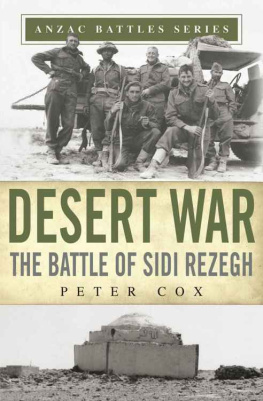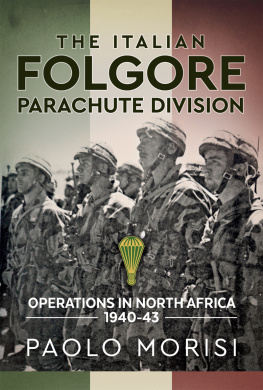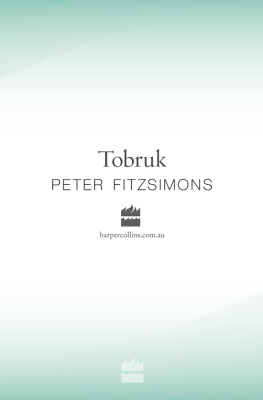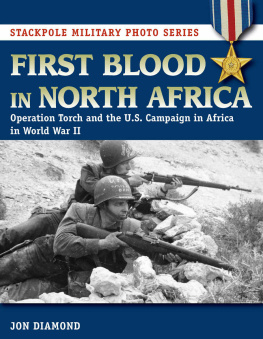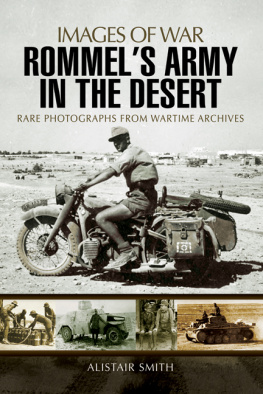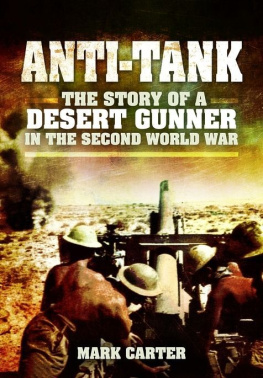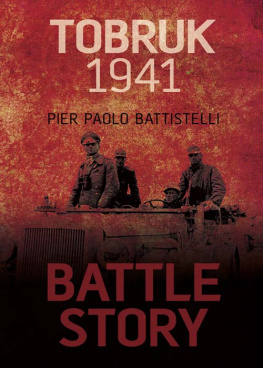ANZAC BATTLES SERIES
Series Editor: Glyn Harper
DESERT WAR
THE BATTLE OF SIDI REZEGH
PETER COX

ANZAC BATTLES SERIES
Series Editor: Glyn Harper
The Anzac Battles Series is a collection of books describing the great military battles fought by Australian and New Zealand soldiers during the wars of the twentieth century. Each title in the series focuses on one battle, describing the background to the action, the combat itself, the strategy employed and the outcome. The story is told through the actions of the main protagonists and the individuals who distinguished themselves in the battle. The authors are all respected military historians with specialist
knowledge of the battles described.
Already available
The Nek: A Gallipoli tragedy
Peter Burness
Dogfight: The Battle of Britain
Adam Claasen
CONTENTS
Epilogue: Return to Sidi Rezegh
Maps
ACKNOWLEDGEMENTS
I am deeply grateful to the many people who have helped me with the preparation of this book, and those who have provided me with family and personal records, diaries, correspondence and photographs of the men who served at Sidi Rezegh. I was extremely fortunate in being able to talk with some of the veterans, several of whom, sadly, have since died.
I wish to record my sincere thanks to the following:
In New Zealand: the family of Bill Andrew; Wayne Hammond, Dianne Richardson and Bunty Hammond, the family of Phil Hammond; Geoffrey Heaps, Hugh Heaps and Majorie Paterson, the family of Eric Heaps; Graeme McIver, Murray and Judy McIver and Violet Williams, the family of Leslie McIver; Russell and Maryann Nelley, and Sam Nelley, the family of Louis Nelley; Bill Paterson, son of Clement Paterson; Eugenie Gatenby and Marise Perry; Harvey Polglase and Michelle Polglase; Edith Costello; Stephanie Handley; Nathania Kenny; Alan Lee; Robert Loughnan; John Staveley; Brian Wintle.
In Britain: Diana Carney, Alf Blacklins eldest daughter; Elizabeth Ramsay and Ruth Stevens, daughters of Randel Heron.
I would also like to thank David Beckingham, Jonathan Forsey, Jan Love and Peter Scott for their assistance; Ian Watt, Professor Glyn Harper and the team from Exisle Publishing for all their work in the production of this book; Fran Whild for her expertise in producing the maps; Anna Rogers, not only for her expertise in editing the book but also for her continuing support and advice throughout the whole process; and my family, Robin, Rebecca and Richard, and David and Kate, for their interest and encouragement and especially Robin, who was my travel companion on our visits to Libya.
Although every effort has been made to ensure the accuracy of information, one of the considerable challenges I found in writing the book was the amount of conflicting information in the various records. I have tried to use information that I considered to be the most authoritative, but if errors do exist, the responsibility is entirely mine.

The Mediterranean area, November 1941
INTRODUCTION
The Forgotten Desert Battle
During the night of 18 November 1941, some 20,000 men of the 2nd New Zealand Division crossed the border from Egypt into Libya. As part of the 118,000-strong British Eighth Army, it was the divisions opening move in Operation Crusader. The campaign had two primary objectives. The first was to destroy German and Italian armoured formations near Tobruk, a Libyan port occupied by the Allies but surrounded by German and Italian forces. The second was to drive the enemy back through Cyrenaica, the eastern region of Libya. If these moves were successful the ultimate objective was the overall defeat of the Germans and Italians in Africa. As the battle unfolded, and as the divisions commander, Major General Bernard Freyberg, had predicted at the outset, much of the New Zealanders battle was fought around a place called Sidi Rezegh, on a barren and stony desert ridge outside Tobruk. The campaign was partially successful, but at a high cost. By the time Crusader ended in early 1942, more New Zealand soldiers had been killed or taken prisoner than in any other campaign the division fought in the Second World War, and more New Zealanders died, were wounded or reported missing than in any other Eighth Army division that took part in the operation. New Zealand casualties totalled 4620: 879 killed, 1699 wounded and 2042 captured.
My interest in Sidi Rezegh arose several years ago when I researched the war history of my father, who fought at Sidi Rezegh. Sergeant Brian Cox was a member of 9 Platoon, 3 Company, 27 (Machine Gun) Battalion. He was only 59 when he died in 1976; he had rarely spoken about his experiences and the subject remained largely dormant until, in 2002, my son asked me what my father had done in the war. That question culminated in my writing Good Luck to All the Lads The Wartime Story of Brian Cox 1939 43, published in 2008. Through the research for that book, including tracking down and talking to several of Brians wartime mates, it became apparent that Sidi Rezegh loomed very large.
Although Brian spoke little about the war I did recall a couple of times when the name Sidi Rezegh was mentioned. The first was in 1958, when a copy of the newly published 27 Battalion volume of the Official War History arrived at home. I asked my father about a photo of him with the gun team, of which he was the leader, on Sidi Rezegh airfield. Brian is sitting in the middle of the group behind a machine gun, looking relaxed and confident, staring straight at the camera, a cigarette dangling from his lower lip. This seemed a very different man from the father I knew, a quiet accountant heavily involved in local sports administration. Over the years I skimmed the book from time to time but did not really understand the context.
The second occasion was in the mid-1960s. I was reading an article about the Battle of El Alamein and asked my father if he had fought there. He replied No, then paused, and said, But I was at Sidi Rezegh. Although he did not elaborate, I sensed that the name held much significance, but I did not press him to explain.
During my research I learnt more about Sidi Rezegh, and through some good luck made contact with John Black from Auckland, a member of Brians platoon. He, in turn, introduced me to Phillip (Phil) Hammond, from Christchurch, who had entered camp at Burnham with my father and was with him at Sidi Rezegh. It was clear that this had been Phils most significant wartime action. Frequently when I visited him he would recount his Sidi Rezegh story and, once started, would look into the middle distance, reliving the day and oblivious to anything going on around him. If he did address me, sitting beside him, he called me Cocky, my fathers nickname. Through his reminiscences I became very familiar with the story of the battle.
Eventually my wife Robin and I decided it was time to see the areas where Brian had fought, so we mapped out an itinerary that covered the main areas of his war journey. Fortunately by 2007, when we planned to go, Libya was opening up to tourists and we were able to visit Sidi Rezegh, travelling to Tobruk by car from Alexandria. Our time in Tobruk was limited, and the visit to Sidi Rezegh brief, but it was enough to give me a sense of the battlefield and we were able to go to the little building known as the mosque, around which much of the battle for the New Zealand soldiers was fought.
Before we reached Libya we had already been to many of the places Brian had seen with the New Zealand Division. In Cairo we had visited We had walked along the Corniche in Alexandria before travelling west through places with names familiar from Brians war story: El Alamein, Mersa Matruh, Sidi Barrani and Sollum.
Next page
